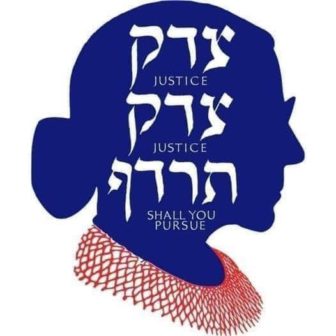Here is an activity you can use with teens to consider the life and legacy of Justice Ruth Bader Ginsburg, z”l. The full session can be found in the Current Events section of our password protected curriculum. If you don’t have access to this section, please fill out this form.
Justice Ginsburg the Tzadeket (5 – 10 minutes)
In Hebrew, a righteous person—or, someone who actively pursues justice in their lifetime—is called a Tzadik or Tzadeket (from the word for justice, tzedek). Given the work of her lifetime, we could consider RBG as a tzadeket, a true pursuer of justice.
(Share your screen with this image)

The Talmud teaches that at any moment in time, there are at least 36 tzadikim living within the world—but their identities are not known. One interpretation of this is the potential for any living person to be one of the 36, to inspire us each to fulfill that potential by actively working for justice in our own ways. And, that each righteous person who dies leaves a mantle to be taken on so that there are always at least 36 righteous people working for justice within the world.
Justice Ruth Bader Ginsburg the tzadeket leaves a legacy of seeking justice that has had major impacts within our society, of being an iconic leader in the revolution of gender equality. And, with her death, there is a baton to be taken from her in the ongoing pursuit of justice, of the revolutionary change that is necessary to achieve justice and equality within our world. If each of us sees ourselves as a potential righteous person who will take that baton—or gavel—from her, then the blessing of her memory may be that it inspires each of us to continue to achieve revolutionary justice. In this way, her legacy does not rest on any one individual, but, an inspiration to us all to pursue justice in our own way—so together, we all are engaged in the pursuit of justice.
How do we decide how to take up that gavel? We don’t need to do it all in the same way. What of her legacy would you like to incorporate in your own way into your own pursuit of justice?
To answer that, I am going to share with you a handful of famous RBG quotes that describe how she thought about her work, her relationships, and about justice and equality. Take a minute to read through them, and then “like” the one that most resonates with you.
Share: Padlet of RBG Quotes
Give the participants 2 – 3 minutes to look through the quotes on their own, and then bring their attention back together by sharing your screen so they can all see the padlet together.
ASK:
Would anyone like to share which quote they chose, and why it resonated with them? (take 1 – 2 responses)
I’d like you to hold the quote you chose, and why you chose it, as inspiration for our last activity. As we talked about together at the start of this session—and saw in the pictures of mourners in front of the Supreme Court—Justice Ginsburg’s death has elicited lots of emotions—either for us personally, or for people we know. It’s important to acknowledge the grief and/or sense of loss you may feel, or any other emotions that you might feel, even as we reflect on her legacy. Others may feel more distant from this loss and that’s really ok too.
(Note: if your group is large, you can send them into breakout rooms to discuss this within hevruta pairs).
